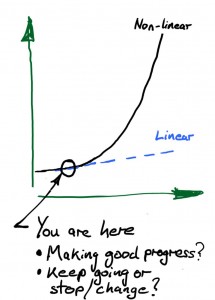 Viral videos and ’10 year overnight successes’ are both examples of non-linear behaviour – future performance is not a simple linear extrapolation of past performance. In the case of both viral videos and ’10 year overnight successes’ performance suddenly grows rapidly after a (sometimes lengthy) period of relatively low success. Both the timing and extent of this rapid change is difficult to predict and plan for. Non-linear behaviour is not always positive. In modern cultures, a rapid fall from popularity when something unexpectedly loses its trendiness is a negative example. A rapid loss of confidence in a business leader or politician is another.
Viral videos and ’10 year overnight successes’ are both examples of non-linear behaviour – future performance is not a simple linear extrapolation of past performance. In the case of both viral videos and ’10 year overnight successes’ performance suddenly grows rapidly after a (sometimes lengthy) period of relatively low success. Both the timing and extent of this rapid change is difficult to predict and plan for. Non-linear behaviour is not always positive. In modern cultures, a rapid fall from popularity when something unexpectedly loses its trendiness is a negative example. A rapid loss of confidence in a business leader or politician is another.
 Why is non-linear behaviour so interesting and important? Because it is helps explain why certain situations change so rapidly and unpredictably. What might appear to be just small inconsequential changes or random ‘noise’ may in fact be the early weak signs of success (or failure). We may think that our new initiative is not working and prematurely abandon or significantly change it. Alternatively, we may see quick success and commit further resources to an initiative or change effort only to find that it expectedly slows down or stagnates. A deeper awareness of the nature and types of non-linear behaviour will sensitise us to the potential for these types of situations and help us look for indicators of non-linear patterns and mechanisms. It will also help us set expectations accordingly.
Why is non-linear behaviour so interesting and important? Because it is helps explain why certain situations change so rapidly and unpredictably. What might appear to be just small inconsequential changes or random ‘noise’ may in fact be the early weak signs of success (or failure). We may think that our new initiative is not working and prematurely abandon or significantly change it. Alternatively, we may see quick success and commit further resources to an initiative or change effort only to find that it expectedly slows down or stagnates. A deeper awareness of the nature and types of non-linear behaviour will sensitise us to the potential for these types of situations and help us look for indicators of non-linear patterns and mechanisms. It will also help us set expectations accordingly.
Sources of non-linear behaviour relevant to organisational and business situations include:
- Self-reinforcing feedback (snowball effect)
- Preferential attachment
- Percolation/connectivity
- Threshold response
- Synergistic effects
- Pressure build-up – Catastrophic failure
- Decision points
- Diversity
A whitepaper that summarises each of these sources can be found here.
Even though the onset of non-linear behaviour is often difficult to predict, we can recognize when the pre-conditions for non-linear behaviour are starting to emerge. Just as geologists know that the preconditions for earthquakes exist in various regions of the world, we can develop expertise in recognizing the development of preconditions for non-linear behaviour in our organization, economy, industry, etc. I suggest that the following are some indicators of such preconditions:
- Periods of (disruptive) transition
- Emergence of imitation based perspectives and decision making
- Emergence of numerous separate but related events, technologies, perspectives:
- Emergence of new enabling technologies
- Broad based constrained pressure for or resistance to change
- Complex initiatives that require broad based integration and coherence for success
In many cases, non-linear behaviour is an emergent property of the situation, not something we can directly engineer and control. In situations such as synergy and diversity, it is possible to take a leading role. In most others, we need to read the dynamics of the situation and find ways to influence, adapt and take advantage of the emerging situation. The following list of potential responses focuses primarily on responding to emergent non-linear behaviour.
- Experiment/probe
- Promote desirable and suppress undesirable trends by influencing the constraints and attractors
- Practise ‘planful opportunism’
- Ride the wave or get out of the way
- Observe, observe, observe
The whitepaper mentioned above explores these preconditions and potential responses. I will also discuss specific examples of non-linear behaviour in more detail in future blog posts.





Speak Your Mind